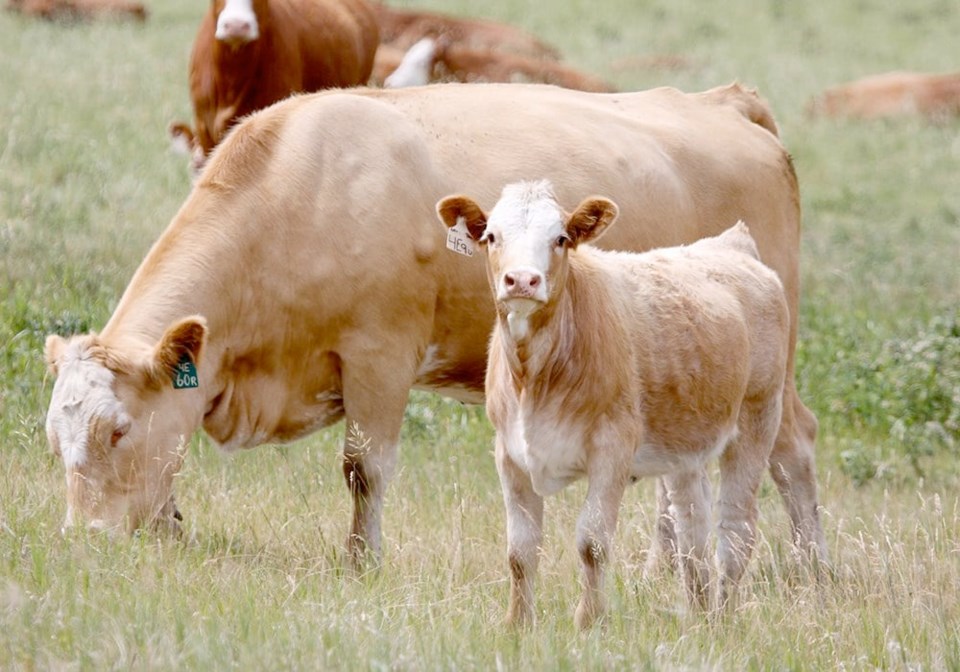WESTERN PRODUCER — Much higher prices for beef stocker calves in the fall run have increased optimism and profits for cow-calf producers after a few challenging years.
“It’s much needed to keep our industry going because our cow-calf guys are working hard on breaking even and doing everything they can to do that, winter grazing and lowering feed costs, but it’s been a real challenge,” says Chad Ross, vice-chair of the Saskatchewan Cattlemen’s Association. He has a cow-calf operation near Estevan, Sask., and also runs a small feedlot.
Prices are about $1 to $1.10 per pound higher for calves above 500 pounds, with lighter steers up $1.50 from a year ago.
Yearlings off grass are about 80 cents higher, says Rick Wright, chief executive officer of the Livestock Markets Association of Canada and a cattle buyer with JGL Livestock.
The number of beef cows on farms in Canada has declined by about 182,000 from 2019, part of a longer-term decline in most areas of the country.
“This thing (strong prices) should last three, four, five years before we see rebuilding of the cow herd,” said Wright.
However, the infrastructure to maintain a cow herd is being lost across the Prairies as tame pasture is tilled under to plant canola, wheat and pulses. Strong crop returns and rising land prices reduce any likelihood that land will be put back into pasture anytime soon.
Cows are losing out as crop markets voraciously compete for land.
Ross has implemented more intensive grazing to run more cows on less land as he tries to compete with neighbours. Maybe with multiple years of record prices for calves, the cows can push back.
“Hopefully we can all get a little piece and keep the cow-calf guy viable,” he said.
The decline in cow numbers means tighter supplies of calves for feedlots in Canada and has turned the country into a net importer of calves.
“For years, cattle moved north to south, but we’ve been a net importer for three years in a row,” said Wright.
Cattle from Montana are moving into Alberta, and cattle from Missouri and Kentucky into feedlots in Ontario, he added.
The higher returns for calves have many impacts across the beef production value chain, and not just to draw more calves from the United States.
The calf run is hitting its peak early, with dry weather at the start of the calf run convincing prairie cow-calf operators to send more calves to auction barns sooner than they usually would.
The heavy fall calf run will reduce the number of calves available in the spring and the number of heifers held back for breeding.
Strong prices for cows and calves could convince even more producers to retire their beef operations, said Keith Day, chair of the Saskatchewan Cattlemen’s Association.
“In extremely dry areas where it’s been dry this fall still, there could be a shortage of water next year, and lots of grass needs to be rested,” he said.
“It encourages more producers to sell because the price is good.”
It might be possible to retain and expand cow herds in areas where the rain has fallen and grass has grown, he added.
The trend to fewer cows next year is expected to keep stocker prices high for a few years.
The beef cut-out price is still strong, processors have had a profitable period and the last turn of feedlots was profitable as well, Ross said.
That should help maintain demand.
The price for stockers has been so good that it is driving smaller calves to market, including a record 12 percent of calves lighter than 400 lb. at the Killarney Auction Mart in mid-October.
“We’re seeing western producers sweeping the pastures,” said Wright, meaning calves are going to auction whether 300 lb. or 700 lb.
“We’ve seen $5 per lb. for some peewee calves and we’ve never seen that before.”
Day said the prices are needed with the increase in costs for farmers.
“We’re very lucky the market is where it is at. The added costs would be almost unbearable if not.”
SASKTODAY.ca is Saskatchewan's home page. Bookmark us at this link.




